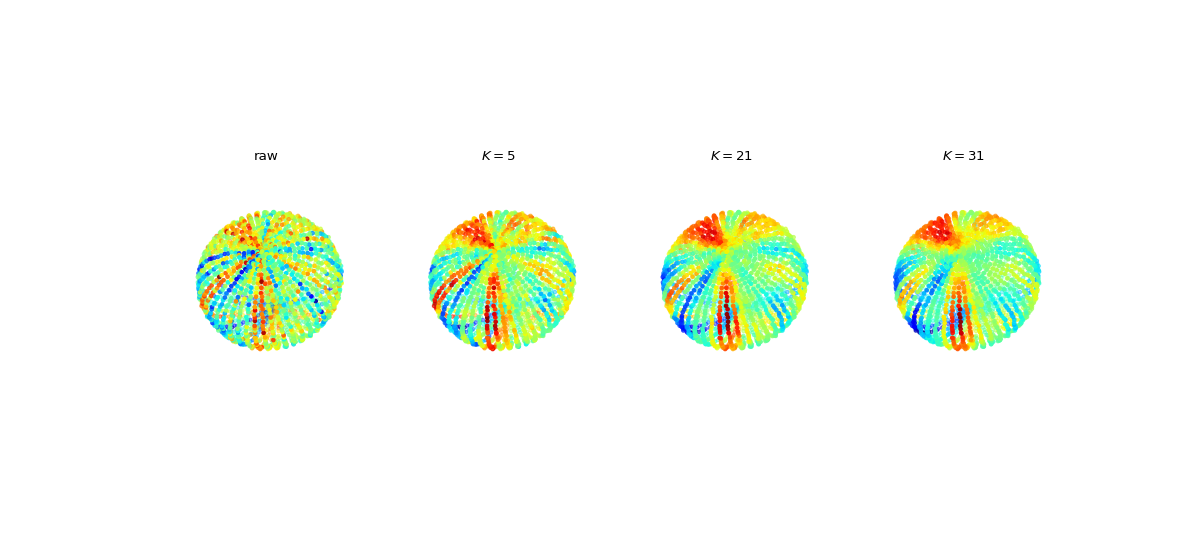spkit.graph_filter_adj¶
- spkit.graph_filter_adj(X, AdjM, V=None, ftype='mean', exclude_self=False, sort_with_dist=False, default_value=nan)¶
Graph Filtering with Adjacency Matrix
Graph Filtering with Adjacency Matrix
A value of a vertice (node) is refined by value of connect vertices (nodes) defined in Adjacency Matrix
The refinement could be - mean, media, standard deviation or any custom operation passed to function as
ftypeCommonly a filter operation could be permutation invariant, such as np.mean, np.median, np.std, However for custom operation passed as functionftype, values can be passed in sorted order by turningsort_with_dist=True- Parameters:
- X: 1d-array (n,)
values of vertices iof graph
- AdjM: array - shape (n,n), binary [0,1]
Adjacency Matrix with 0s and 1s
0 mena not connected, 1 means connected
- V: array - shape (n,d), default=None
location of vertices in d-dimensional sapce
for 3D Geomartry, (n,3)
used if
sort_with_distis True
- ftype: str, or Callable, default=’mean’
filter operation, {‘mean’,’median’,’std’,’min’,’max’} or any numpy operation as str = ‘np.newfun’
using ‘mean’ , value of vertices is refined with average of neibours defined by distance d.
if
ftypeis callable, make sure it return single value given neigbours values
- exclude_self: bool, default=False,
if True, while refining/filtering the value of the vertice, value of itself if excluded.
- default_value: float, default=np.nan
default value to start with.
In case of no neibours and excluding itself, vertices will have this value.
- sort_with_dist:bool, default=False
if True, values passed to filter are sorted in order of smallest distance to largest
in case of permutation variant filter, this could be used.
it adds extra computations, so turn it off, if not useful.
- Returns:
- Y: 1d-array of same size as X
refined/filtered values
See also
spkitHome
Notes
This function ..
Examples
#sp.graph_filter_adj import numpy as np import matplotlib.pyplot as plt import spkit as sp V = sp.geometry.get_ellipsoid(n1=50, n2=50, rx=1, ry=2, rz=1,) V += 0.01*np.random.randn(V.shape[0],V.shape[1]) X = sp.create_signal_1d(V.shape[0],bipolar=False,sg_winlen=21,sg_polyorder=2,seed=1) X += 0.1*np.random.randn(X.shape[0]) AdjM1, _ = sp.geometry.get_adjacency_matrix_kNN(V, K=5) AdjM2, _ = sp.geometry.get_adjacency_matrix_kNN(V, K=21) AdjM3, _ = sp.geometry.get_adjacency_matrix_kNN(V, K=31) Y1 = sp.graph_filter_adj(X,AdjM1,ftype='mean',exclude_self=False) Y2 = sp.graph_filter_adj(X,AdjM2,ftype='mean',exclude_self=False) Y3 = sp.graph_filter_adj(X,AdjM3,ftype='mean',exclude_self=False) fig, ax = plt.subplots(1,4,subplot_kw={"projection": "3d"},figsize=(15,7)) Ys =[X, Y1, Y2, Y3] TITLEs = ['raw', r'$K=5$',r'$K=21$', r'$K=31$'] for i in range(4): ax[i].scatter3D(V[:,0], V[:,1], V[:,2], c=Ys[i], cmap='jet',s=10) ax[i].axis('off') ax[i].view_init(elev=60, azim=45, roll=15) ax[i].set_xlim([-1,1]) ax[i].set_ylim([-2,2]) ax[i].set_zlim([-1,1]) ax[i].set_title(TITLEs[i]) plt.subplots_adjust(hspace=0,wspace=0) plt.show()






